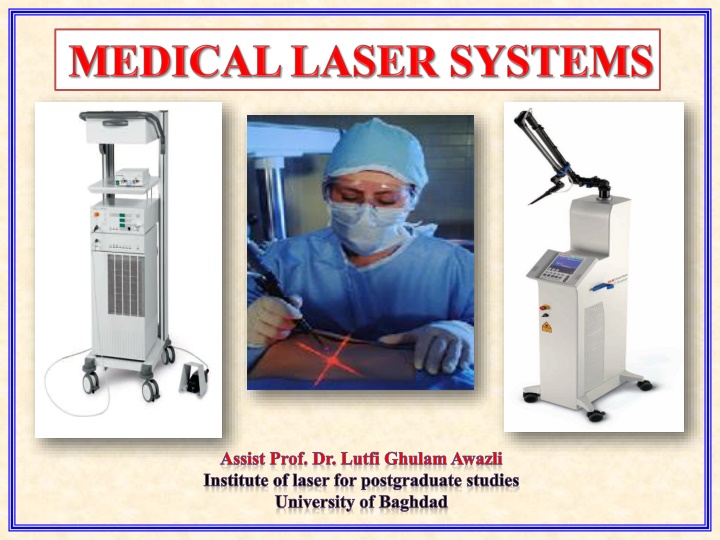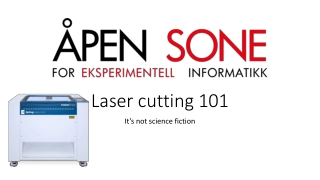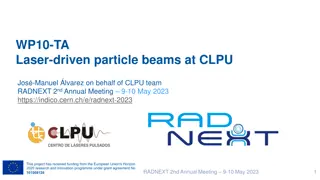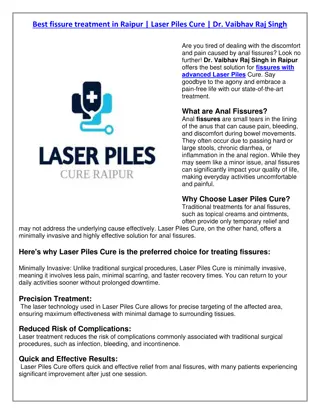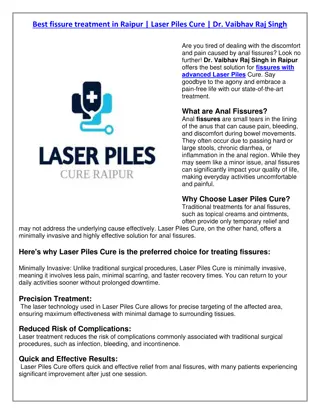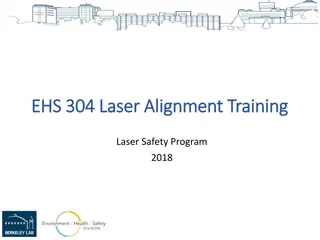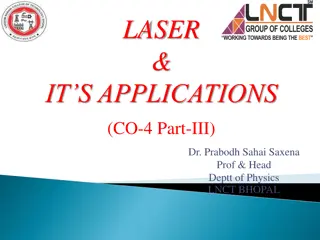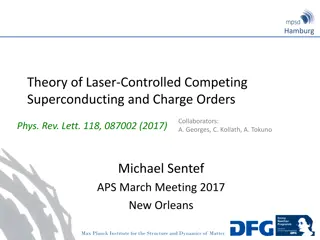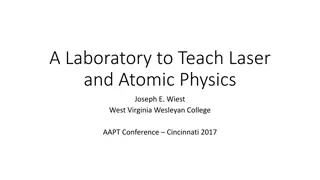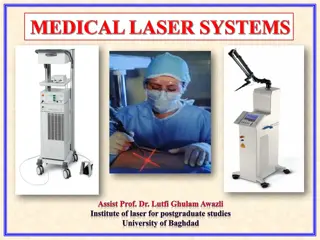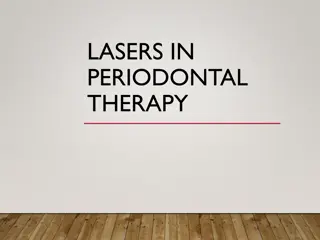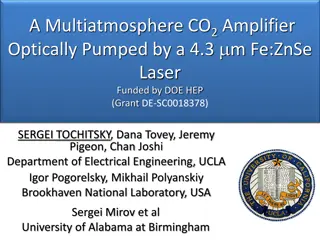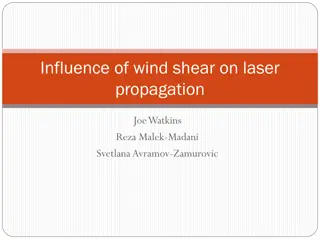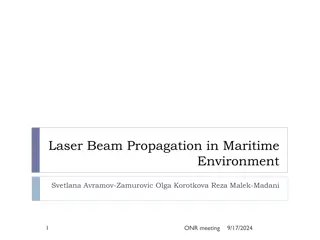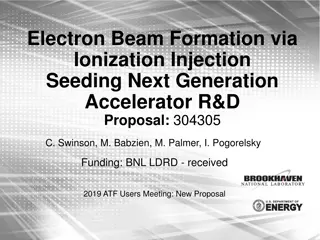Basics of Laser Components
Fundamental components of lasers, including the active medium, excitation mechanism, and optical resonator. Learn about the role of these components in generating laser light and amplifying the beam for various applications.
Download Presentation

Please find below an Image/Link to download the presentation.
The content on the website is provided AS IS for your information and personal use only. It may not be sold, licensed, or shared on other websites without obtaining consent from the author.If you encounter any issues during the download, it is possible that the publisher has removed the file from their server.
You are allowed to download the files provided on this website for personal or commercial use, subject to the condition that they are used lawfully. All files are the property of their respective owners.
The content on the website is provided AS IS for your information and personal use only. It may not be sold, licensed, or shared on other websites without obtaining consent from the author.
E N D
Presentation Transcript
Assist Prof. Dr. Lutfi Ghulam Awazli Institute of laser for postgraduate studies University of Baghdad
COMMON COMPONENTS ( ELEMENTS ) OF ALL LASERS : All lasers, regardless of size, shape, style, or application, have three main components: 1. Active Medium The active medium is a collection of atoms, molecules or ions that absorb energy source and generate laser light by stimulated emission from an outside. The active medium can consist of a solid, liquid, gas or a semiconductor material. 2. Excitation Mechanism Excitation mechanisms pump energy into the active medium by one or more of three basic methods; optical, electrical or chemical. 3. Optical Resonator Reflect the laser beam through the active medium for amplification. It is consist of:- - High Reflectance Mirror: A mirror which reflects 100% of the laser light. - Partially Transmissive Mirror: A mirror which reflects less than 100% of the laser light and transmits the remainder (The output coupler ).
LASER COMPONENTS ACTIVE MEDIUM Optical Resonator 3- Solid (Crystal) Gas Semiconductor (Diode) Liquid (Dye) Output Beam 1- Active Medium EXCITATION MECHANISM High Reflectance Mirror (HR) Output Coupler Mirror (OC) Excitation Mechanism 2- Optical Electrical Chemical The Active Medium contains atoms which can emit light by stimulated emission. 1- OPTICAL RESONATOR 2- The Excitation Mechanism is a source of energy to excite the atoms to the proper energy state. HR Mirror and Output Coupler The Optical Resonator reflects the laser beam through the active medium for amplification. 3- Laser-Professionals.com
1-ACTIVE LASER MEDIUM OR GAIN MEDIUM: Laser medium is the heart of the laser system and is responsible for producing gain and subsequent generation of laser. The active medium is a collection of atoms or molecules that can be excited to a state of inverted population; that is, where more atoms or molecules are in an excited state than in some lower energy state.. The two states chosen for the lasing transition must possess certain characteristics:- First, atoms must remain in the upper lasing level for a relatively long time to provide more emitted photons by stimulated emission than by spontaneous emission. Second, there must be an effective method of "pumping" the atoms from the highly populated ground state into the upper lasing state in order to increase the population of the higher energy level over the population in the lower energy level.
The active medium may be a gas, a liquid, a solid , or semiconductor materials. The material should have the suitable energy levels to support population inversion. In other words, it must have a metastable state to support stimulated emission. Most lasers are based on 3 or 4 level energy level systems, which depends on the lasing medium. These systems are shown in figs 3a and 3b. In case of a three-level laser, the material is pumped from level 1 to level 3, which decays rapidly to level 2 through spontaneous emission. Level 2 is a metastable level and promotes stimulated emission ( laser transition ) from level 2 to level 1.
On the other hand in a four level laser, the material is pumped to level 4, which is a fast decaying level, and the atoms decay rapidly to level 3, which is a metastable level. The stimulated emission takes place from level 3 to level 2 from where the atoms decay back to level 1. Four level lasers is an improvement on a system based on three level systems. In this case, the laser transition takes place between the third and second excited states. Since lower laser level 2 is a fast decaying level which ensures that it rapidly gets empty and as such always supports the population inversion condition
2- EXCITATION OR PUMPING MECHANISM: The excitation mechanism is a source of energy that excites, or "pumps," the atoms in the active medium from a lower to a higher energy state in order to create a population inversion. There are various types of excitation or pumping mechanisms available, the most commonly used ones are optical, electrical, thermal or chemical techniques, which depends on the type of the laser active medium employed. For example : In gas lasers and semiconductor lasers, the excitation mechanism usually consists of anAC or DC electrical- discharge current flow through the active medium. Solid and liquid lasers most often employ optical pumps.
3- OPTICAL RESONATORS (FEDBACK MECHANISM) : Optical resonator (Optical cavity ) plays a very important role in the generation of the laser output, in providing feedback of the laser light and high directionality to the laser beam as well as producing gain (Amplification: the gain must be larger than the total loss) in the active medium to overcome the losses due to, straying away of photons from the laser medium, diffraction losses due to definite sizes of the mirrors, radiation losses due to absorption and scattering. In order to sustain laser action, one has to confine the laser medium and the pumping mechanism in a special way that should promote stimulated emission rather than spontaneous emission. This is achieved by bounding the laser medium between two mirrors one at each end of the active medium, aligned in such a manner that they reflect the coherent light back and forth through the active medium.creating more stimulated emission as they go. On one end of the active medium is the high reflectance mirror (100% reflecting) or the rear mirror and on the other end is the partially reflecting or transmissive mirror or the output coupler. The laser beam leave the laser system from the output coupler, as it is partially transmissive .
Threshold Gain Coefficient ( G ): To sustain laser oscillations the gain coefficient must be at least large enough to overcome the losses in the laser system. The sources of loss include the following: 1. Transmission, absorption and scattering by the mirrors. 2. Diffraction around the boundary of the mirrors. 3. Absorption and scattering in the laser active medium. If G < unity then the oscillations would die out, and G > unity then the oscillations would grow.
http://upload.wikimedia.org/wikipedia/commons/c/ca/Optical-cavity1.pnghttp://upload.wikimedia.org/wikipedia/commons/c/ca/Optical-cavity1.png Figure 2: The five possible types of stable cavities showing the radiation pattern inside each cavity
Optical resonator (Cavity configuration ) types : Different resonator types are distinguished by the various curvatures (different shapes) and the focal lengths of the two mirrors and the distance between them. The cavity is designed so that the beam will remain entirely within the cavity's mirrors. These are referred to as follows where R1 and R2 are the radii of curvature of the mirrors and L is the distance between the mirrors: a) Plane-parallel R1=R2= b) Concentric (spherical) R1+R2=L c) Confocal R1+R2=2L d) Hemispherical R1=L, R2= e) Concave-convex R1>L, R2=L-R1
Graphically, Figure 3 shows a plot of the stability region of cavities. If g1 and g2 are such that their intersection lies within the shaded region of this diagram, then the cavity is stable. Figure 3: The stability diagram.
Mode volume : The volume inside the cavity actually occupied by the laser beam Stimulated emission occurs only within this volume. The selection of the Optical resonator (Cavity configuration) for a particular laser depends upon the following factors: 1. Ease of alignment. 2. Diffraction loss. 3. Mode volume.
1)The plane - parallel cavity. Difficult to align. Highest diffraction loss. Highest mode volume No focusing inside the active medium. Example: Pulsed solid state lasers. 2)The spherical cavity Easiest to align. Lowest diffraction loss. Smallest mode volume. focusing inside the active medium. Example: dye lasers.
3)The confocal resonator. Ease of alignment. Low diffraction loss. Moderate in the mode volume. 4)The hemispherical cavity. One-half of the spherical cavity. Characteristics is similar. Low cost of the mirror. Example: Most low power He-Ne laser.
